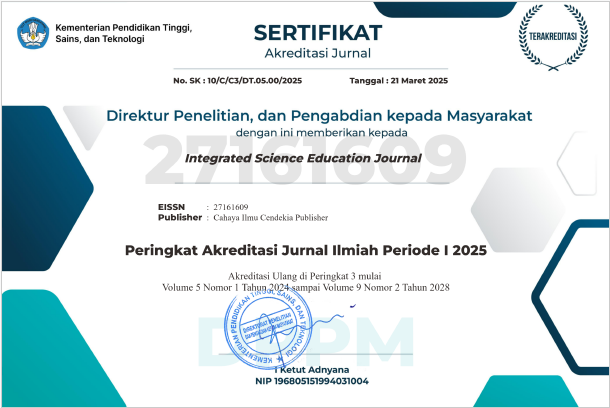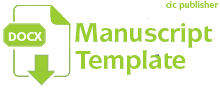Implementation of Problem Based Learning Model as an Effort to Improve Student Activities and Outcomes in Temperature and Heat Materials
Abstract
Purpose of the study: This study aims to determine whether learning using the Problem-Based Learning model can increase student activity and learning outcomes in class X heat and temperature material, especially class XB SMA Xaverius 2 Jambi.
Methodology: This research is a classroom action research carried out in three cycles. The types of data in this study were qualitative and quantitative data collected through formative tests and observations of teacher and student activities through observation sheets.
Main Findings: The results showed that using the Problem-Based Learning learning model increased student learning activities and resulted in each cycle. In cycle I, the average proportion of student activity was 69.07%. In cycle II, it was 79.85%, and in cycle III, it was 86.88%.
Novelty/Originality of this study: Research by applying the Problem-Based Learning learning model in physics learning to increase student activity and learning outcomes on the subject of temperature and heat in class X SMA Xaverius 2 Jambi.
References
N. Yuliwulandana, “Evaluasi Pedidikan,” Metro: STAIN Jurai Siwo, 2015
M. Fadilah, “Implementasi Kurikulum 2013 Dalam Pembelajaran,” Yogyakarta: ArRuzz Media, 2014.
H. B. Uno, “Model Pembelajaran,” Jakarta: Bumi Aksara, 2014.
F. S. Raharjo., R. Sulistiyono., and N. S. Widyastuti, “Penerapan Model Problem Based Learning dan Media Sway Secara Daring Terhadap Motivasi Belajar Peserta didik Pada Pembelajaran Tematik Di Kelas III SD Unggulan ‘Aisyiyah Bantul,” Prosiding Pendidikan Profesi Guru Fakultas Keguruan dan Ilmu Pendidikan Universitas Ahmad Dahlan, vol. 1, no. 1, pp. 1237-1251, 2019.
C. Suhana, “Konsep Srategi Pembelajaran,” Bandung: Refika Aditama, 2014.
S. Sagala, “Konsep Dan Makna Pembelajaran (Untuk Membantu Memecahkan Problematika Belajar Dan Mengajar),” Bandung: AlfaBeta, 2013.
S. A. Shirali, “George Pólya & problem solving. An appreciation,” Resonance, vol. 19, no. 4, pp. 310-322, 2014.
S. Arikunto, “Penelitian Tindakan Kelas,” Jakarta: Bumi Aksara, 2014.
A. Prabowo., D. Suryadi., and D. Dasari, “Analysis of mathematical didactic situation constructed by prospective teachers based on learning trajectory,” In Journal of Physics: Conference Series (vol. 1918, no. 4, p. 042051). IOP Publishing, 2021.
J. Murtini., W. S. Utami., and E. Budiyanto, “Penerapan Model Pembelajaran Blended Learning Dengan Media Sway Pada Materi Peta Untuk Meningkatkan Hasil Belajar Siswa Kelas X Ilmu Sosial 1 Sma Negeri 3 Jombang Tahun Pelajaran 2018/2019,” Jurnal Education and Development, vol. 9, no. 1, pp. 314-314, 2021.
J. W. Creswell., and C. N. Poth, “Qualitative inquiry and research design: Choosing among five approaches,” Sage publications, 2016.
F. A. Astiar., and R. Satianingsih, “Keterampilan Berbicara Siswa Sekolah Dasar Melalui Project Based Learning,” Primary: Jurnal Pendidikan Guru Sekolah Dasar, vol. 9, no, 5, pp. 672-679, 2020.
Z. Aqib, “Profesionalisme Guru dalam Pembelajaran,” Bandung: Yrama Widya, 2021.
Purwanto. “Evaluasi Hasil Belajar,” Yogyakarta: Puataka Belajar, 2014.
R. A. Sani, “Pembelajaran Saintifik (Untuk Implementasi Kurikulum 2013),” Jakarta: Bumi Aksara, 2014
A. Shoimin, “68 Model Pembelajaran Inovatif dalam Kurikulum 2013,” Yogyakarta: Ar-ruzz Media, 2017
E. Ekawarna., M. Salam., and Y. Anra, “Memilih Masalah Untuk Penelitian Tindakan Kelas: Bahan kajian untuk pelatihan Guru menyusun Laporan hasil PTK,” Jurnal Karya Abdi Masyarakat, vol. 5, no. 1, pp. 52-62, 2021.
Q. A. Bankole., and Z. Nasir, “Empirical Analysis of Undergraduate Students’ Perception in the Use of Electronic Sources in Kwara State University Library,” International Information & Library Review, vol. 53, no. 2, pp. 131-141, 2020.
Copyright (c) 2023 Dina Wulan Suci Rahadiyani, Putri Ayu Rivani, Florentina Untari

This work is licensed under a Creative Commons Attribution-NonCommercial 4.0 International License.
Authors who publish with this journal agree to the following terms:
- Authors retain copyright and acknowledge that the Integrated Science Education Journal is the first publisher licensed under a Creative Commons Attribution 4.0 International License.
- Authors are able to enter into separate, additional contractual arrangements for the non-exclusive distribution of the journal's published version of the work (e.g., post it to an institutional repository or publish it in a book), with an acknowledgment of its initial publication in this journal.
- Authors are permitted and encouraged to post their work online (e.g., in institutional repositories or on their website) prior to and during the submission process, as it can lead to productive exchanges and earlier and greater citation of published work.







.png)
.png)






